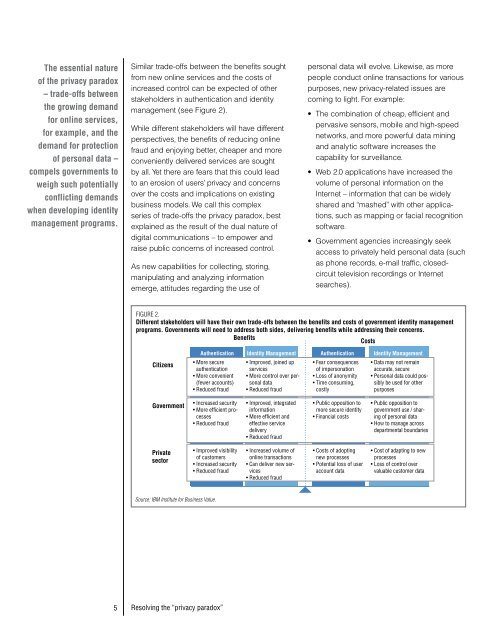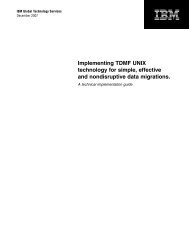Resolving the "privacy paradox" - IBM
Resolving the "privacy paradox" - IBM
Resolving the "privacy paradox" - IBM
Create successful ePaper yourself
Turn your PDF publications into a flip-book with our unique Google optimized e-Paper software.
The essential nature<br />
of <strong>the</strong> <strong>privacy</strong> paradox<br />
– trade-offs between<br />
<strong>the</strong> growing demand<br />
for online services,<br />
for example, and <strong>the</strong><br />
demand for protection<br />
of personal data –<br />
compels governments to<br />
weigh such potentially<br />
conflicting demands<br />
when developing identity<br />
management programs.<br />
Similar trade-offs between <strong>the</strong> benefits sought<br />
from new online services and <strong>the</strong> costs of<br />
increased control can be expected of o<strong>the</strong>r<br />
stakeholders in au<strong>the</strong>ntication and identity<br />
management (see Figure 2).<br />
While different stakeholders will have different<br />
perspectives, <strong>the</strong> benefits of reducing online<br />
fraud and enjoying better, cheaper and more<br />
conveniently delivered services are sought<br />
by all. Yet <strong>the</strong>re are fears that this could lead<br />
to an erosion of users’ <strong>privacy</strong> and concerns<br />
over <strong>the</strong> costs and implications on existing<br />
business models. We call this complex<br />
series of trade-offs <strong>the</strong> <strong>privacy</strong> paradox, best<br />
explained as <strong>the</strong> result of <strong>the</strong> dual nature of<br />
digital communications – to empower and<br />
raise public concerns of increased control.<br />
As new capabilities for collecting, storing,<br />
manipulating and analyzing information<br />
emerge, attitudes regarding <strong>the</strong> use of<br />
5 <strong>Resolving</strong> <strong>the</strong> “<strong>privacy</strong> paradox”<br />
personal data will evolve. Likewise, as more<br />
people conduct online transactions for various<br />
purposes, new <strong>privacy</strong>-related issues are<br />
coming to light. For example:<br />
• The combination of cheap, efficient and<br />
pervasive sensors, mobile and high-speed<br />
networks, and more powerful data mining<br />
and analytic software increases <strong>the</strong><br />
capability for surveillance.<br />
• Web 2.0 applications have increased <strong>the</strong><br />
volume of personal information on <strong>the</strong><br />
Internet – information that can be widely<br />
shared and “mashed” with o<strong>the</strong>r applications,<br />
such as mapping or facial recognition<br />
software.<br />
• Government agencies increasingly seek<br />
access to privately held personal data (such<br />
as phone records, e-mail traffic, closedcircuit<br />
television recordings or Internet<br />
searches).<br />
FIGURE 2.<br />
Different stakeholders will have <strong>the</strong>ir own trade-offs between <strong>the</strong> benefits and costs of government identity management<br />
programs. Governments will need to address both sides, delivering benefits while addressing <strong>the</strong>ir concerns.<br />
Benefits<br />
Costs<br />
Citizens<br />
Government<br />
Private<br />
sector<br />
Source: <strong>IBM</strong> Institute for Business Value.<br />
Au<strong>the</strong>ntication Identity Management<br />
• More secure<br />
au<strong>the</strong>ntication<br />
• More convenient<br />
(fewer accounts)<br />
• Reduced fraud<br />
• Increased security<br />
• More efficient processes<br />
• Reduced fraud<br />
• Improved visibility<br />
of customers<br />
• Increased security<br />
• Reduced fraud<br />
• Improved, joined up<br />
services<br />
• More control over personal<br />
data<br />
• Reduced fraud<br />
• Improved, integrated<br />
information<br />
• More efficient and<br />
effective service<br />
delivery<br />
• Reduced fraud<br />
• Increased volume of<br />
online transactions<br />
• Can deliver new services<br />
• Reduced fraud<br />
Au<strong>the</strong>ntication Identity Management<br />
• Fear consequences<br />
of impersonation<br />
• Loss of anonymity<br />
• Time consuming,<br />
costly<br />
• Public opposition to<br />
more secure identity<br />
• Financial costs<br />
• Costs of adopting<br />
new processes<br />
• Potential loss of user<br />
account data<br />
• Data may not remain<br />
accurate, secure<br />
• Personal data could possibly<br />
be used for o<strong>the</strong>r<br />
purposes<br />
• Public opposition to<br />
government use / sharing<br />
of personal data<br />
• How to manage across<br />
departmental boundaries<br />
• Cost of adapting to new<br />
processes<br />
• Loss of control over<br />
valuable customer data

















